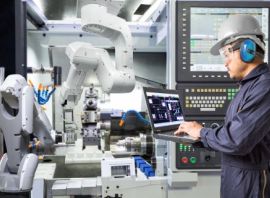The Fourth Edition of UL 1740 “Standard for Robots and Robotic Equipment” was released on 21/01/2018. The publication of the revised edition marked a significant shift from RIA R15.06 (2012) to the latest edition of ISO 10218 (2011).
As you can imagine, this meant a major re-write to the definitions and test specifications within UL 1740 to align with the international robotics standard. This shift will define the shape of the robotics industry for years to come.
Changes to the standard
The alignment of UL 1740 with ISO 10218 (2011) meant a large portion of changes between editions were to the glossary in order to harmonise with international standards and other UL standards. The most significant revised definition was that of the actual term “robot,” conforming with the definition in ISO 8373 (2012).
|
3RD EDITION DEFINITION |
4TH EDITION DEFINITION |
|
Automatically controlled, re-programmable multipurpose machine, programmable in several degrees of freedom, which can be either fixed in place or mobile. |
Actuated mechanism programmable in two or more axes with a degree of autonomy, moving within its environment, to perform intended tasks. |
New safety testing requirements were also added to the new edition, again to align with new and revised international safety standards and to stay ahead of constantly evolving technologies. For example, Clause 40.4.7 was added to allow for Manual High Speed (APV or T2) functions and to be consistent with ISO 10218-1.
In all, significant editorial changes and clarifications throughout changed the way manufacturers, integrators, and users approach the standard.
What do organisations need to be aware of?
 Most manufacturers of this type of equipment understand the previous requirements very well but may not have kept up to date with all of the changes to the requirements. It is also important for them to understand the relationship between UL 1740, ANSI / RIA R15.06, CSA Z-434, ISO 10218-1 and other functional safety standards.
Most manufacturers of this type of equipment understand the previous requirements very well but may not have kept up to date with all of the changes to the requirements. It is also important for them to understand the relationship between UL 1740, ANSI / RIA R15.06, CSA Z-434, ISO 10218-1 and other functional safety standards.
Integrators and robot users are not expected to have the same level of understanding of these changes to UL 1740 as manufacturers, because the details of many modifications do not make a big impact to their day-to-day work. Their main responsibility will be in keeping to the original designed safety plan of the manufacturer’s robot in order to maintain compliance to the updated standard.
As a whole, organisations may need to review their current UL 1740 certifications in order to ensure that they are complying with Fourth Edition requirements.
For more information on UL 1740 or other Product Certification matters, contact our experts:



